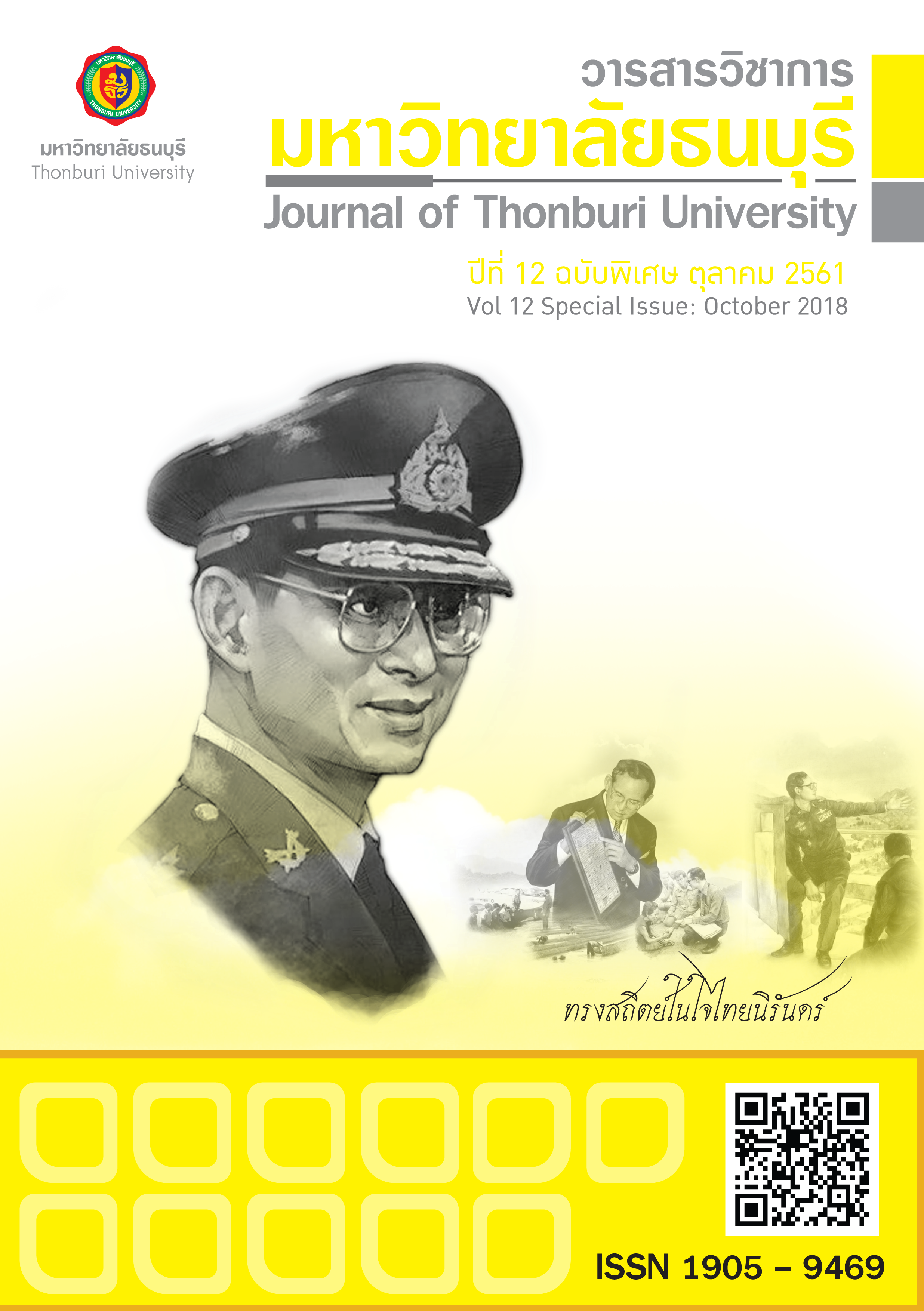การจัดการทุนมนุษย์สมัยใหม่ ยุคเจนเนอเรชั่น วาย ระดับปฏิบัติการ : กรณีศึกษา สถานประกอบการในนิคมอุตสาหกรรมภาคเหนือ ลำพูน
คำสำคัญ:
พฤติกรรมการปฏิบัติงาน, การจัดการทุนมนุษย์, พนักงานยุคเจนเนอเรชั่น วาย, ปัจจัยบำรุงรักษา, ปัจจัยจูงใจบทคัดย่อ
บทคัดย่อ
การวิจัยนี้มีวัตถุประสงค์เพื่อ 1) วิเคราะห์อิทธิพลของปัจจัยแรงจูงใจ ได้แก่ ปัจจัยจูงใจ และปัจจัยบำรุงรักษาที่มีผลต่อพฤติกรรมการปฏิบัติงาน และความสนใจในงานและองค์การ 2) พัฒนาแบบจำลองความสัมพันธ์ระหว่างปัจจัยแรงจูงใจ กับพฤติกรรมการปฏิบัติงาน และความสนใจในงานและองค์การ ของพนักงานยุคเจนเนอเรชั่น วาย ระดับปฏิบัติการ ในสถานประกอบการ นิคมอุตสาหกรรมภาคเหนือ ลำพูน โดยสุ่มตัวอย่างอย่างง่าย จำนวน 410 ตัวอย่าง เครื่องมือที่ใช้ในการวิจัยคือแบบสอบถาม และวิเคราะห์ข้อมูลพื้นฐานโดยใช้ สถิตเชิงพรรณนา และแบบจำลองสมการโครงสร้าง (SEM) โดยวิเคราะห์ด้วยลิสเรล
ผลการวิจัยพบว่า ปัจจัยจูงใจมีอิทธิพลทางตรงเชิงบวกต่อพฤติกรรมเกี่ยวกับการปฏิบัติงาน และปัจจัยบำรุงรักษามีอิทธิพลทางตรงเชิงบวกต่อความสนใจในงานและองค์การ ที่ระดับนัยสำคัญ 0.01 จึงเป็นการชี้ชัดได้ว่าแนวทางในการปรับนโยบายการจัดการทรัพยากรมนุษย์ตามแบบจำลองความความสัมพันธ์ สำหรับพนักงานยุคเจนเนอเรชั่น วาย ระดับปฏิบัติการ ในอนาคต จึงควรจัดกิจกรรมการจูงใจที่มีความหลากหลาย โดยการปรับเปลี่ยนพฤติกรรมการปฏิบัติงานของพนักงานยุคเจนเนอเรชั่น วาย ให้เป็นไปตามที่องค์การต้องการ ควรมุ่งใช้ปัจจัยจูงใจ ส่วนการปรับเปลี่ยนทัศนคติของของพนักงานยุคเจนเนอเรชั่น วาย เพื่อให้เกิดความสนใจในงานและองค์การ ควรมุ่งใช้ปัจจัยบำรุงรักษา ได้แก่เงินเดือนและสวัสดิการที่เหมาะสม ความมั่นคงในงาน และความสัมพันธ์อันดีกับเพื่อนร่วมงานและผู้บังคับบัญชา
คำสำคัญ: พฤติกรรมการปฏิบัติงาน, การจัดการทุนมนุษย์, พนักงานยุคเจนเนอเรชั่น วาย, ปัจจัยบำรุงรักษา, ปัจจัยจูงใจ
เอกสารอ้างอิง
ชัชชัย พันธุ์เกตุ. (2559). การบริหารทรัพยากรมนุษย์ในยุคการแข่งขัน. สืบค้นเมื่อ 2 กรกฎาคม 2559, จาก www.hu.ac.th/academic/article/HR/chatchai.htm
ชูเกียรติ ยิ้มพวง. (2554). แรงจูงใจที่มีผลต่อการปฏิบัติงาน กรณีศึกษา บริษัท บางกอกกล๊าส จำกัด โรงงานจังหวัดปทุมธานี. บริหารธุรกิจมหาบัณฑิต, มหาวิทยาลัยเทคโนโลยีราชมงคลธัญบุรี
ปิยะวัฒน์ จารุธนรัตน์กุล. (2559). ทุนมนุษย์. สืบค้นเมื่อ 8 สิงหาคม 2559, จาก www.thaihrm.com/articledetail. asp?id=2974
รัชฎา อสิสนธิสกุล. (2559). แนวคิดด้านการบริหารทรัพยากรมนุษย์ยุคใหม่: คอลัมน์ HR Conner. สืบค้นเมื่อ 9 มิถุนายน2559, www.gotoknow.org/posts/267913
สถาบันเอ็นเทรนนิ่ง. (ม.ป.ป.). คน Gen Y คืออะไร ทำไมองค์กรต่าง ๆ ควรต้องเจียระไนคน Gen Y? สืบค้นเมื่อ 15 กรกฎาคม 2559, www.entraining.net/article-paradorn_gen- y.php
สุรัสวดี สุวรรณเวช. (2549). ความผูกพันต่อองค์การของพนักงาน. วารสารการบริหารสำหรับนักบริหารงานบุคคลมืออาชีพ. 27(3): 30-31.
Albanese Robert. (1981). Managing: Toward accountability for performance. 3rd edn. Homewood, IL: Richard D. Irwin.
Becker Gary S. (1994). Human Capital. Chicago: University of Chicago Press.
Ferreira, Teresa Santos. (2017). Motivational factors in sales team management and their influence on individual performance. Tourism & Management Studies. 13(1): 60-65.
Herzberg Frederick, Mausner Bernard and Snyderman Bloch Barbara. (1959). The motivation to work. New York: John Wiley & Sons.
Maka, Brenda L. and Sockelb, Hy. (1999). A confirmatory factor analysis of IS employee motivation and retention. Journal of Information & Management. 38(2001): 256-276.
McShane Steven and Von Glinow Mary Ann. (2004). MARS Model of Individual Behavior and Results Organizational Behavior. 7thed. New York: McGraw-Hill.
Robbins Stephen P. (1993). Organizational Behavior : Concepts Controversies and Applications. New York : Prentice–Hall Inc.
Strauss William and Howe Neil. (1992). Generations: The History of America's Future, 1584 to 2069. London: HarperCollins.
Vance, Robert J. (2006). Engagement and Commitment: A Guide to Understanding, Measuring and Increasing Engagement in Your Organization . Duke Street, Alexandria: SHRM Foundation Press.
Translated Thai References
Asisonthisakul, R. (2016). Modern Human Resource Management Concept: HR Conner column. Retrieved June 9, 2516, from www.gotoknow.org/posts/267913 (in Thai).
Charuthanaratkul, P. (2016). Human Capital. Retrieved August 8, 2516, from www.hu.ac.th/academic/ article/ HR/chatchai.htm (in Thai).
Entraining Institution. (n.d.). What is Gen Y? Why should organizations retouch the Gen Y? Retrieved July 15, 2516, from www.entraining.net/article-paradorn_gen- y.php (in Thai).
Krajangsaeng, Kanokporn and Jadesadaiug, Viroj. (2017). The Influence of The Motivation to work and Organization Support That Affect The Quality of Performance Through Organization Commitment of The Personnel Nakornthon Hospital. Journal of Thonburi University. 11(26): 116-129. (in Thai).
Panket, C. (2016). Human resource management in the Social Enterprises in the competitive era. Retrieved July 2, 2016, from www.hu.ac.th/academic/article/HR/chatchai.htm (in Thai).
Suwanwech, Suratsawadee. (2006). Employee Engagement. Journal of Management for Professional Personnel Management. 27(3): 30-31. (in Thai).
Yimpuang, C. (2011). Motivational factors affecting operation : Case study of Bangkok glass Co.,ltd Pathumthani plant. (Master of Business Administration Independent Study, Rajamangala University of Technology Thanyaburi). (in Thai).







